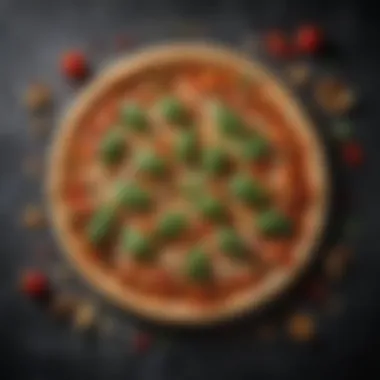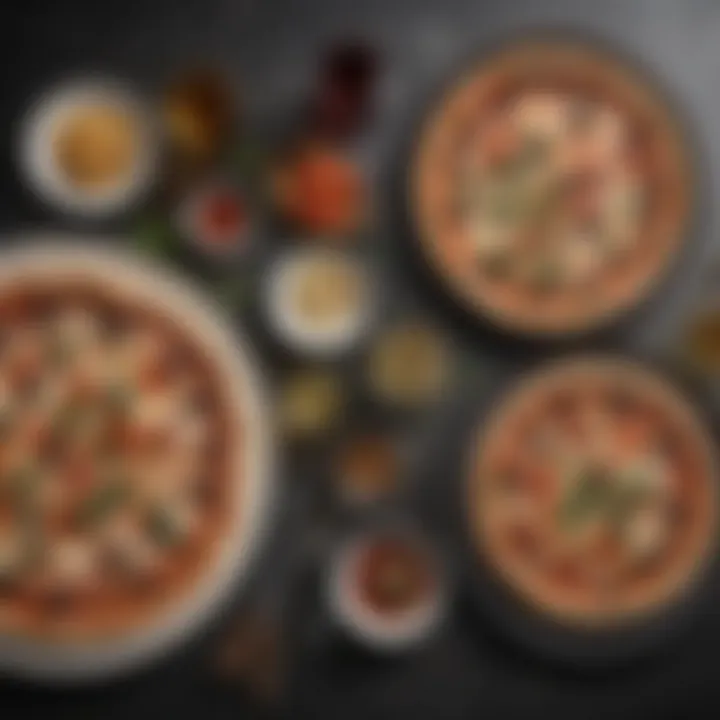Discovering Pizza Pasta: A Unique Culinary Fusion


Intro
Pizza pasta combines the beloved elements of two classic dishes into one delightful meal. This dish embraces the best of Italian cuisine, taking the savory goodness of pizza toppings and merging them with the comforting texture of pasta. It caters to those who appreciate hearty flavors and filling meals, making it a popular choice for families and individuals alike.
In this article, we're going to explore every aspect of making pizza pasta, including its origins, the best ingredients to use, cooking methods you should try, and additional ways to customize this dish according to your preferences. We aim to make this culinary journey both insightful and accessible, guiding novice cooks and seasoned chefs through the world of pizza pasta.
Recipe Highlight
Introducing Pizza Pasta Medley: a mouthwatering fusion that tantalizes the taste buds with a balance of cheese, savory meat, and the flavor-packed essence of tomato sauce.
Essential Ingredients:
- Pasta of choice (penne or fusilli works well)
- Olive oil
- Italian sausage or pepperoni
- Marinara sauce
- Mozzarella cheese
- Bell peppers
- Onion
- Fresh basil for garnish
Preparation Time:
Estimated time to prepare is about 30-40 minutes.
Servings:
This recipe yields roughly 4 servings.
Step-by-Step Instructions
- Start by boiling the pasta in a large pot of salted water according to the package instructions. Remember to cook until just al dente, as it will continue to cook in the oven later.
- While the pasta cooks, heat olive oil in a skillet over medium heat. Add the sliced sausage or pepperoni and cook until browned for enhanced flavor.
- Toss in sliced onions and bell peppers. Sauté until they become soft and translucent, usually around 3 to 5 minutes.
- Drain the pasta and mix it with the cooked meat and vegetables in a large bowl. Add marinara sauce and half of your mozzarella cheese. Stir gently so that everything combines evenly.
- Transfer the mixture to a baking dish and top it with the remaining mozzarella cheese. Aquí you can also sprinkle some oregano if desired.
- Bake at 350°F (175°C) for about 20 minutes or until the cheese is golden and bubbling.
- Garnish with fresh basil before serving.
Insider advice: Ensure to not overcook the pasta, as it can lead to a mushy dish.
Common mistakes to avoid include using too much sauce, which may leave the pasta swimming instead of coating it adequately.
Variations and Substitutions
Consider the following options to tailor this recipe:
- For a vegetarian version, substitute meat with mushrooms or zucchini.
- Add extra flavor by incorporating Pesto sauce or crushed red pepper flakes ahead of baking.
- Serve alongside a crisp salad or garlic bread for a complete meal experience.
Time-Saving Cooking Tips
- Prep your ingredients in advance. Chopping vegetables and having the sauces ready can save valuable time.
- If you use pre-cooked pasta or even rotini, the process becomes even quicker.
- Using a food processor can greatly speed up chopping vegetables.
By multiplying your ingredients, you can easily cook enough for several meals and store leftovers. Reheating pizza pasta is quick in the microwave or oven.
Nutritional Information
- Each serving contains approximately 500 calories.
- Key nutrients include protein from cheese and meat, fiber from vegetables, and essential vitamins.
- This dish can be adapted for various diets. For example, using gluten-free pasta meets the needs of those avoiding gluten.
Enjoy the explosive flavors of pizza pasta while keeping in mind how adaptable and modifiable it can be. This dish not only satisfies cravings but provides a canvas for creativity in the kitchen.
Prologue to Pizza Pasta
Pizza pasta is more than just a coupling of two beloved dishes. It represents an intersection of flavors, styles, and culinary traditions. Understanding this fusion is essential as it highlights the creativity and adaptability in cooking. For home cooks and food enthusiasts, diving into the world of pizza pasta creates an opportune moment to blend the familiarity of pasta with the boldness of pizza.
Another factor to consider is the diversity of ingredients and preparations involved in making pizza pasta. This mix reaffirms the trend fully supported by varied palates, allowing for personal expressions in every dish shared around a kitchen table. Each version brings its unique essence, catering to different taste preferences and dietary considerations. This second dimension prompts a broader investigation of how culinary cultures innovate with simplicity in mind.
As we step through the foundational aspects of pizza pasta, the underlying benefits illustrate its versatility. Not only does it provide a chance to creatively utilize leftovers, but it also encapsulates a comforting meal suitable for family dinners as well as sophisticated gatherings.
The Concept of Pizza Pasta
The idea of pizza pasta is simple yet intriguing. It allows ingredients used in traditional pizza, like tomato sauce, cheese, and various toppings, to be integrated into pasta dishes. The objective remains to maintain the comforting essence while elevating flavors to new heights.
This culinary conceptualization invites forressional integrity. It pushes cooks to rethink popular ingredients, explore unexpected satisfactions in texture, and create aesthetic presentations. Key considerations include how sauces can marry with cooked pasta and the overall balance of flavors that authentically honors the originating cuisines.


The recipe development aspect of pizza pasta lends itself well to experimentation. From forgoing staple pepperoni for more exotic meats to making the dish entirely vegetarian with roasted vegetables, possibilities abound. Each variation provides opportunity for more personalized spin and distinctive reflections of local flavors.
Brief History of Fusion Recipes
The world of cooking is filled with inventive creations. Fusion recipes have been evolving over centuries, chronicled by influences that span genres and borders. Traditionally seen as cultural integrations of various cooking methods, fusion cuisine demonstrates a specific interaction of background flavors and techniques.
Pizza pasta emerges by embracing dining tradition, stemming both from Italian roots. The merging of pasta and pizza resonates with youthful energy and the idea of making traditional concepts accessible. International history showcases fusion musicals. Through wars and trade, edible mixtures form regional constellations. Mexico and its empanadas, Korea with bulgogi or even American Mu'rrisa Griros highlight a few advanced examples in gastronomic histories.
Exploring fusion can lead to culinary creativity, witnessed through unexpected unifications like pizza pasta. Understanding this fosters greater culinary curiosity and encourages readers to delve into the broader history behind their own cooking experiences. Such insights are essential, bridging generations and trends.
Fusion cooking can reveal uncharted flavor territories; allowing chefs and home cooks alike to draw lines between cultures while rethinking dish fundamentals.
Ingredients for Pizza Pasta
Understanding the Ingredients for Pizza Pasta is an essential aspect of creating this dish. Each ingredient contributes to the overall flavor and texture, bridging elements from the treasured traditions of both pizza and pasta. When selecting your ingredients, it’s important to favor quality. High-quality ingredients can elevate a simple recipe into something remarkable.
Essential Ingredients
The backbone of pizza pasta consists of a few key elements:
- Pasta: Typically, penne or fusilli works best due to their ability to catch sauce.
- Pizza Sauce: A traditional tomato-based sauce forms the core. It should be rich in flavor and balanced in acidity.
- Cheese: Opt for mozzarella as it provides the essential gooey texture and character. Parmesan can amplify depth with its sharpness.
- Vegetables: Bell peppers, onions, or mushrooms add freshness and contrast in texture. They serve to enhance not just flavor but also the nutrition profile.
When used together, these ingredients create a base that is adaptable and resonates with classic Italian culinary tenets.
Optional Add-Ons
While it’s a great foundation, Optional Add-Ons can cater to varied palates:
- Proteins: Chicken, pepperoni or sausage can provide additional heartiness and satisfy meat lovers.
- Leafy Greens: Spinach or arugula can introduce a nutritious layer, giving a refreshing crunch.
- Spices: Red pepper flakes can add a hint of heat, while fresh basil leaf or oregano extends the aroma and viscosity of flavor.
These add-ons allow for personal touches, inviting individual creativity into each dish.
Ingredient Quality and Sourcing
The impact of Ingredient Quality and Sourcing is profound when it comes to successful cooking. Here are several considerations:
- Freshness: Choose freshly made pasta or higher-quality dry varieties. Look for bright and vibrant vegetables, as freshness often translates to enhanced flavor.
- Local Sources: Use ingredients from local farms or markets when possible. Seasonal produce not only tastes better but supports community agriculture.
- Organic Options: For those concerned about health, opting for organic vegetables and meats ensures fewer chemicals in your meals.
Taking extra time to seek out quality ingredients can make a significant difference, leading to a pizza pasta experience that is both satisfying and desirable.
Preparation Techniques
Preparation techniques play a pivotal role in the process of making pizza pasta. Understanding these techniques not only enhances the final dish, but it also allows for a smoother cooking experience. Moreover, each technique contributes to the unique characteristics of pizza pasta, marrying the elements of traditional pizza with comforting pasta in a wholly satisfying meal.
Cooking the Pasta
The foundation of pizza pasta starts with cooking the pasta. It is essential to choose the right type of pasta. Options like penne or fusilli work well due to their ability to hold sauces. Cooking the pasta until it reaches al dente texture is ideal. Too soft pasta can become mushy when mixed with sauce, undermining teksture. It's important to salt the boiling water before adding the pasta to enhance flavor. After draining, you can toss the pasta with a small amount of olive oil to prevent sticking.
Making the Sauce
Sauce selection is critical in pizza pasta. Typically, a tomato-based sauce forms the base, rich in flavor and aroma. Consider adding ingredients such as garlic, herbs, and spices to elevate the depth. Incorporating onion can add sweetness, balancing out the acidity of tomatoes. Another effective technique is simmering the sauce for a longer time. This allows flavors to meld while thickening the sauce. Always taste and adjust seasoning at this point to satisfy personal preferences.
Combining Ingredients
With both components cooked, combining ingredients is the next step. The method depends on desired end-result. Mixing the pasta with the sauce directly in the pot allows for even coating. This step can also integrate other ingredients such as cooked vegetables or proteins. Whether sautéed mushrooms or grilled chicken, it should complement the overall dish and not compete with the flavors.
Baking the Dish
The final technique is baking the assembled dish. This step adds a layer of crunch and complexity. Use a suitable baking dish, such as a casserole dish, and layer the pasta and sauce accordingly. For enhanced flavor, consider topping with cheese like mozzarella or parmesan. If health is a concern, reduced-fat options can also work. Bake until cheese melts and becomes bubbly, usually around 20-30 minutes at 350°F. This step not only melds flavors but also creates a comforting, hearty meal, ready to serve.
In summary, following these preparation techniques ensures a well-balanced pizza pasta experience that captures the depth of its Italian roots while being suited to various palates.
Step-by-Step Recipe Instructions


Step-by-step recipe instructions are crucial when making pizza pasta. These guidelines provide clarity, allowing even novice cooks navigate through each phase confidently. A detailed approach makes difficult processes easier to understand. Each step builds on the previous one, ensuring that flavors blend correctly and the final dish achieves the anticipated taste and texture.
Using these instructions, cooks can stay organized in the kitchen, manage their time effectively, and prevent stress. This comprehensive structure aligns perfectly with the habits of busy lifestyles, proving valuable for anyone wanting a satisfying meal without heavy preparation time.
Preparation Timeline
To ensure optimal flavors and texture, a preparation timeline is essential. It brings coherence to the cooking process. Below is an ideal estimate of the time required from start to finish:
- Gathering Ingredients: 5-10 minutes. Ensure all essential items are present before diving into the actual cooking process.
- Cooking Pasta: 8-12 minutes. Make sure to use a large pot of boiling water and salt adequately for flavorful pasta.
- Making Sauce: 15-20 minutes. Allow sufficient time for sautéing aromatics and fully developing flavors.
- Combining Ingredients: 3-5 minutes. This includes tossing the cooked pasta with the sauce, inviting the flavors to meld.
- Baking the Dish: 15-25 minutes. The baking phase allows flavors to enhance and create that classic pizza crust top.
In total, expect around 45 to 70 minutes for completing the pizza pasta recipe. Adjust individual items based on personal kitchen efficiency and consequently treat the times as guidelines rather than rigid rules.
Visual Guides for Each Stage
Visual guides can enhance the culinary experience for visual learners. They provide clarity and context that written instructions alone often lack. Helpful imagery or diagrams at each stage can look something like this:
- Step 1: Organize Ingredients
- Step 2: Cooking Pasta
- Step 3: Sauce Preparation
- Step 4: Combining Ingredients
- Step 5: Final Baking
Illustrative content emphasizes importance of precision in each step. This format makes the cooking process accessible and enjoyable while reducing possible errors during execution.
Customization Options
Customization is a critical focal point for this pizza pasta recipe. It empowers individuals to tailor the dish to meet unique preferences and dietary needs. The blending of flavors from both pizza and pasta creates opportunitiess to enhance or alter the dish. This flexibility ensures that it can satisfy diverse tastes—whether one seeks distance from meat or is inclined toward hearty proteins. Adapting ingredients allows for personal expression in the kitchen, resulting in a meal that truly reflects one’s culinary style or dietary restrictions.
Vegetarian Variations
For those embracing a meat-free lifestyle, vegetarian variations of pizza pasta can be rich and satisfying. Incorporating an array of vegetables boosts not only flavor but also nutrition. Consider adding ingredients such as bell peppers, zucchini, and spinach. These ingredients can add textures and tastes to contrast the pasta.
Using plant-based proteins is another way to enhance these variations. Options like tofu, chickpeas, or lentil-based crumbles introduce additional protein without meat. Many pantry staples, such as canned olives or artichokes, can also contribute depth to the dish. Additionally, substituting dairy with nut-based cheese can cater to those looking for a completely plant-based experience.
Meat Lovers’ Adaptations
Conversely, for meat enthusiasts, meat lovers’ adaptations can transform the pizza pasta into a dynamic feast. Options for proteins are vast here. Ground beef, Italian sausage, or chunks of pepperoni blend well with the saucy pasta dish. Mixing various types of meats can create layers of flavor. It is possible to create a meaty boldness by sautéing these proteins ahead of time and adding them during the combining stage.
Furthermore, the richness of the sauce can be accentuated with bacon or prosciutto. These can add that addictive saltiness that complements both tomato and cheese elements.
Gluten-Free Alternatives
There is a growing appreciation for gluten-free diets, and therefore gluten-free alternatives should not be overlooked. Springing forth are a variety of gluten-free pasta options made from corn, rice, or lentils. This offers versatile substiutes without a loss of authentic pasta texture. It’s crucial that when selecting gluten-free products, one reads labels to ensure there are no hidden gluten ingredients.
In addition, sauces should always be scrutinized for gluten presence, particularly with pre-made options. For added flavor, incorporating gluten-free grains, such as quinoa or farro, can also present an excellent alternative. This approach ensures that even those adhering to strict dietary guidelines can savor a delightful meal, capturing the essence of pizza pasta without sacrificing flavor or structure.
Serving Suggestions
Serving suggestions play a vital role in elevating the pizza pasta experience to new heights. They are not merely an addition to the meal; they enhance the overall enjoyment and provide a comprehensive dining experience. By carefully selecting accompaniments and presentation styles, one can highlight the flavors of the dish while catering to various culinary preferences.
Accompaniments and Pairings
When it comes to complements for pizza pasta, several options can amplify the dish's flavor profile. Here are some accompaniments to consider:
- Garlic Bread: This classic side is a natural fit. The crispy texture and rich buttery flavor add a satisfying crunch that pairs well with the cheesy, hearty pasta.
- Green Salad: A simple green salad made with mixed greens, cherry tomatoes, and a light vinaigrette can provide the necessary contrast to the richness of pizza pasta. It refreshes the palate; the lightness balances the heaviness of a carb-laden meal.
- Dessert Options: Following a meal of pizza pasta, a light dessert is often appreciated. Options like tiramisu or panna cotta maintain the Italian theme without overpowering.
- Wine Pairings: Choose a medium-bodied red wine, such as Chianti or Pinot Noir. These wines can complement the spiciness of the dish without overshadowing the flavors.
- Beer Selections: A pale ale can offer a crisp contrast. Alternatively, a refreshing lager can enhance the flavors without competing.
Ultimately, accompaniments offer an opportunity to fine-tune your serving style for pizza pasta, making every meal more memorable.
Presentation Ideas
Visual appeal can amplify the overall dining experience. Presenting pizza pasta attractively adds an element of anticipation when your guests sit down to eat. Here are some effective suggestions:
- Serve in Individual Dishes: Small cast iron skillets or ceramic dishes can create a rustic feel. This approach encourages sharing and instantly makes the meal more intimate.
- Garnish Smartly: A sprinkle of fresh basil or parsley can add a dash of color and a fresh taste. A light drizzle of olive oil enhances the richness Q. Parmesan cheese can provide a finishing touch for visual allure.
- Layering: When plating, alternate the layers of pasta, sauce, and toppings in a clear bowl for a layered effect that will entice even the eyes. Not only does this look appealing, but it also allows diners to gauge the balance of ingredients at a glance.


Presenting food beautifully enhances the overall dining experience, making it not just about what you eat, but how you feel while eating.
By considering these serving suggestions and presentation ideas, one can ensure the pizza pasta experience is not only tasty but also visually appealing and fulfilling.
Nutritional Considerations
Understanding the nutritional components of any dish is crucial, especially when it merges two beloved cuisines like pizza and pasta. For readers who prioritize both flavor and health, various considerations emerge. These not only include caloric intake but also the nutritional quality of ingredients used in pizza pasta. A thoughtful approach here gives room for balance - a satisfying meal that does not compromise one’s fitness goals.
Balancing Flavor and Nutrition
The key to crafting a pizza pasta that remains wholesome while flavorful lies in selecting ingredients wisely. Whole grain pasta is an excellent introductory option, as it offers higher fiber content than standard pasta, promoting better digestion and lasting fullness. Combine this with a sauce made from fresh tomatoes, herbs, and perhaps spinach or other vegetables. They not only bring layers of rich flavor but also essential vitamins and antioxidants.
Many pizza lovers appreciate cheese. Limiting cheese or choosing a lower-fat variety can aid in achieving a more balanced dish without losing the creamy texture that meats pizza so iconic. Importantly, looking at alternatives such as feta or part-skim mozzarella would maintain the taste without solely focusing on high-calorie options.
Remember, portions matter as ingredients stack up quickly. The goal is to create a robust meal but mindful of total calorie intake and overall nutritional balance. Identifying food items that naturally add more nutrition will contribute a remarkable dimension to what might seem like merely a comfort dish.
Portion Control Insights
Portion control plays a substantial role in enjoying pizza pasta without overwhelming one's diet. Serving suggestions can significantly guide how we consume this delightful dish. Employing a mindful approach encourages eating only what is necessary for satisfaction while being attentive to hunger signals. For effectiveness, consider these strategies:
- Use Smaller Plates: Psychology plays a big part in how much we serve on our plates. Tiny behavior change results in reduced portion sizes automatically.
- Measure Ingredients: Being precise can often make you more aware of the food quantity, allowing for adjustments that appease flavor cravings without excess.
- Include Vegetables: Filling half of your plate with greens substantially reduces calorie density, yet maintaining volume and satisfaction. It allows one to indulge in sauce and pasta without overloading on calories.
Looking past sheer portions enables a fuller understanding of overall food intake. It also ensures longevity in indulging without severe guilt, heavy surprises on weighing scales. By following practical insights in portion control, these made-from-scratch dishes still fit health regimes individual’s maintain.
Nutritional awareness lets individuals fully enjoy the delicious confection contained within every bite while caring for their health.
Strategic selections paired with mindful portioning can pave an enjoyable journey within culinary creation and consumption.
Storing and Reheating Leftovers
Properly storing and reheating leftovers is not merely a matter of convenience; it significantly affects food quality, safety, and ultimately, the dining experience. With the unique pizza pasta dish, the balance of flavors and textures is paramount. If not handled effectively, the mixture of pasta, sauce, and toppings can suffer from deterioration, leading to an unsatisfactory meal. This section will discuss essential storage techniques, along with the best practices for reheating, ensuring that each bite retains its intended garlicky, cheesy essence.
Proper Storage Techniques
Implementing the right storage technologies can maintain the quality of pizza pasta as well as other similar dishes. Here are the practices you should follow when storing leftovers:
- Container Selection: Choose airtight containers to minimize air exposure. Glass containers are ideal, as they are non-reactive and help retain flavors.
- Cooling Process: Before storing, let the pizza pasta cool down to room temperature. This helps prevent condensation inside the container, reducing the risk of mushiness.
- Portioning: If you plan to eat the pizza pasta over several days, it is sensible to portion it out at the outset. Individual servings allow for easier reheating and help maintain moisture levels with less chance of overcooking.
- Labeling and Dating: To avoid confusion, label each container with the date of storage. Consume the leftovers within three to four days for the best taste and safety, although securely frozen portions can last up to a couple of months.
Handling pizza pasta with care during storage preserves its taste and encourages more sustainable practices in the kitchen.
Best Reheating Practices
Reheating pizza pasta improperly can lead to dryness or unhappiness in taste, so following the right methods is key to preserving flavor and texture. Here are some effective reheating strategies:
- Using the Oven: For a crispy finish, reheating in an oven is recommended. Preheat the oven to 350°F (175°C) and place the pizza pasta in an oven-safe dish. Cover it with foil to retain moisture and bake it for about 20 minutes, or until heated through.
- Microwaving: A quicker option is the microwave. Transfer several small portions to a microwave-safe bowl. Sprinkle a little water or broth to maintain moisture, cover with a microwave-safe lid or plate, and heat for 1-2 minutes. Stir halfway through for even heating.
- Skillet Method: For an even outlook while promoting homemade feel, tried reheating leftover pizza pasta on the stovetop. In a nonstick skillet over medium heat, add a splash of water or sauce, add the pasta, and stir intermittently until warm. This method can also rejuvenate flavors.
- Tip: Avoid reheating on high heat. This can lead to uneven warming or dried-out surfaces.
Choosing the right techniques not only elevates the pizza pasta experience but focuses on quality and safeguards against food waste.
The End
The conclusion demarcates a significant turn in this article. It serves to consolidate the various ideas and reflections on the preparation and appreciation of pizza pasta. Pizza pasta blends familiar flavors of Italy with creativity in a unique way. A proper ending acknowledges the intricate journey through this culinary exploration. It also offers insights into flavor balance, customization, and enjoying meals with loved ones.
Reflecting on the Experience
Creating pizza pasta involves more than just combining pasta and pizza elements. The experience enhances food appreciation. Engaging in this cooking adventure invites memories of family dinners. It stretches beyond consumption to connect with history. Each step in preparation fosters a relationship with tradition and innovation. Taste testers may find texture variety, and flavors will evoke emotions learning new techniques also raises confidence in the kitchen.
Adapting recipes can be a way to nurture personal family traditions. The pizza pasta interacts differently with various ingredients, offering a novel experience with every attempt. New cooks just beginning feel satisfaction in forming something remarkable. For more seasoned individuals, it can represent opportunities to elevate skills toward something extraordinary.
Encouragement to Experiment
This culinary journey deserves exploration beyond what is listed in recipes. Flexible ingredients such as cheese, sauce, and vegetables invite diverging routes to pizza pasta perfection. Why not try unexpected cheeses like gorgonzola or a herb-infused sauce? Diversifying textures through roasted cherry tomatoes or creamy ricotta can inspire diverse combinations.
Mindfully approach substitutions. Tofu or tempeh in a meatless version supplies protein with style. Personalize your creation to evoke flavors that resonate with your palate.
So, do not fear the experimentation process; embrace it. Each new endeavor can serve as a learning season in your cooking adventure that ultimately dictates growth in flavor proficiency and creativity alongside specific studies related to cultural blending. The options are plentiful, with every bite holding potential to convey your unique touch on a shared classic.







